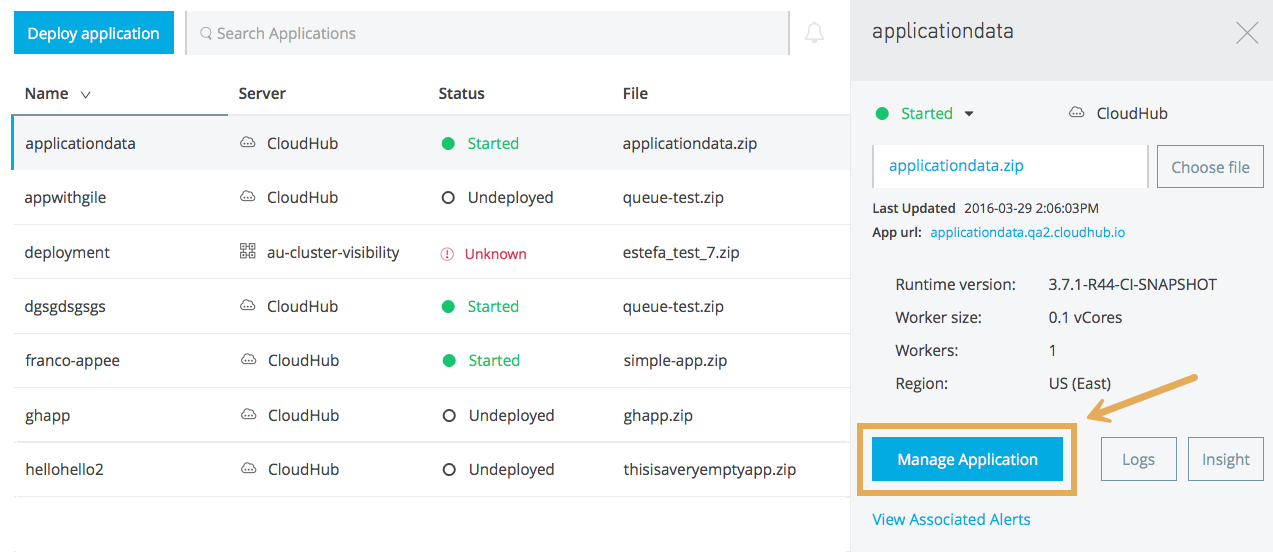
Manage Deployed Applications
After you deploy apps, use the Runtime Manager console to monitor and manage running applications. The different management functionalities available depend on the deployment option you use.
The basic management tools in the Runtime Manager console enable you to perform the following tasks:
For applications deployed to your own servers, you can also:
On applications deployed to CloudHub 2.0, you can also:
On applications deployed to CloudHub, you can also:
On applications deployed to Anypoint Runtime Fabric, you can also:
Applications Tab
In Runtime Manager, an "application" is a Mule application that is running on a Mule runtime engine (Mule) or an API gateway runtime instance. The instance can be running in CloudHub, in an on-premises server of your organization, in a group of servers, or in a server cluster.
In the Applications menu, you can get a quick view of the applications that are currently deployed and running for your account. Click an entry to display additional information (as shown here), or click Manage Application to see the application’s dashboard and settings page:

After you create at least one application, you can see your applications listed here.
An application deployed to a server group runs on every server in the group.
Servers Tab
This tab is used only to deploy apps to on-premises servers. CloudHub workers aren’t displayed here.
In Runtime Manager, a "server" is a Mule or API gateway instance in a location other than CloudHub (on-premises or in a different cloud server) that you must first register in the Runtime Manager console. After you register and configure your server, you can deploy your applications to it from the Applications tab.
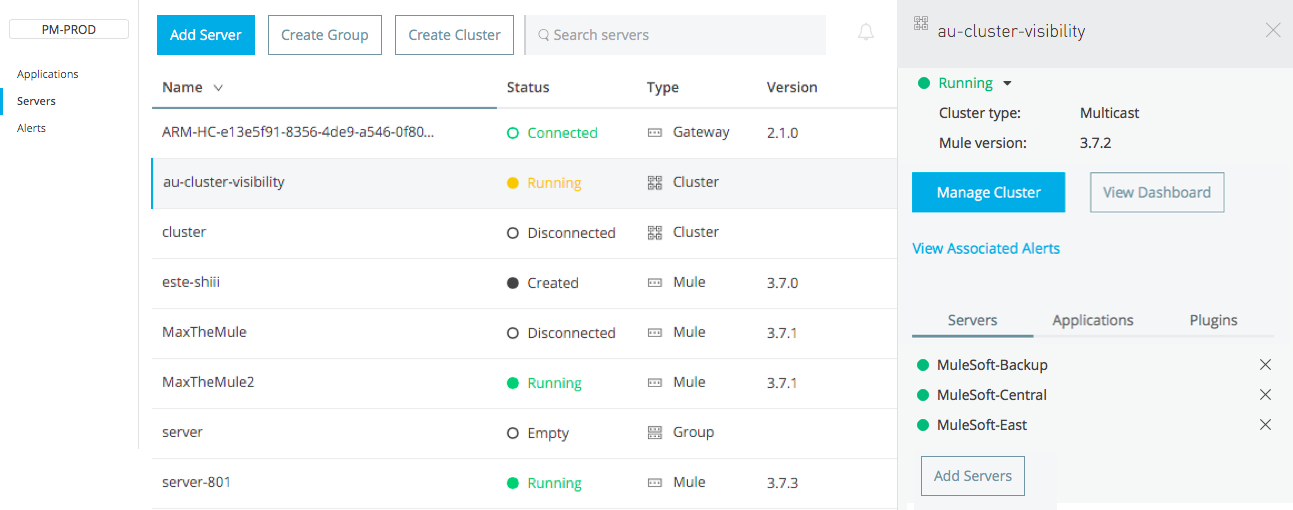
From the Servers tab, select one of the following options to perform these tasks:
-
Add a Server (registers the server with the Runtime Manager console)
-
Start Mule or API gateway
-
Create a server group
-
Create a cluster
-
Add and remove servers from a server group
-
Add and remove servers from a cluster
-
Stop an application on a server
-
Delete a server, server group or cluster
For more about the options on this tab, see Servers, Server Groups, and Clusters.
Switch Environments
If you have multiple environments in your organization, you can switch between them:
-
From any screen in Runtime Manager, click the current environment, which is displayed in the upper left corner of the screen.
-
Select the environment to switch to.
-
Click Switch.
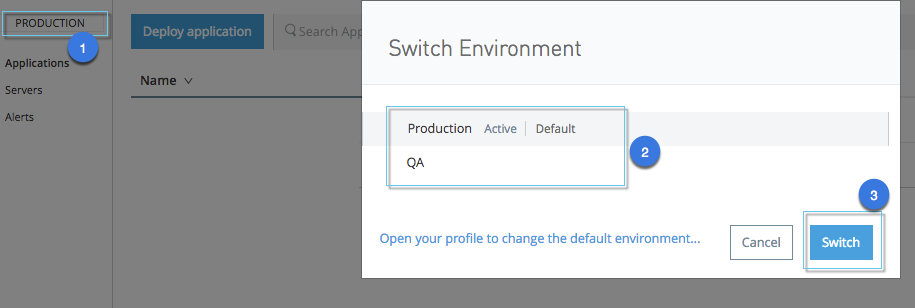
Start, Restart, Stop, or Delete an Application
-
In Applications, click an application name to open its management panel on the right side of the screen.
-
Next to the status, click the down-arrow (the menus differ according to the app’s current state):
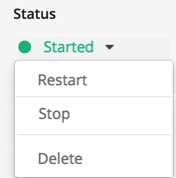
-
Click the action to perform:
-
Start
Starts stopped applications
-
Restart
Resets applications that have already started. If the application is undeployed, the application’s ZIP file is sent to the server to start the application on the server.
-
Stop
Stops running applications.
-
Delete
Deletes the application.
-
If you’re deploying your application to an on-premises cluster, Runtime Manager starts/stops/deletes the application simultaneously on each server.
| On CloudHub, after you delete an application, your log data is no longer accessible from the console. CloudHub archives old log data for a limited period of time before it is purged. This allows you to recover the data if needed. Open a support case at: MuleSoft Help Center for more information. |
Status States
The information in the Status column depends on the context:
Application Status States
| Icon | State | Description |
|---|---|---|

|
|
The application is not running. |

|
|
Application is in the process of transitioning to another state. |
|
|
Application is running or the update succeeded. The Application shows Started when running on at least one of the Cluster nodes. |
|
|
Application deployment failed. The cause of the failure appears in the console. |

|
Application update failed. |
Application Deployment States
| Icon | State | Description |
|---|---|---|

|
Deleted |
Application is deleted. |

|
Applying |
Application is in the process of transitioning to another state. |
|
Applied |
Application is running or the update succeeded. |
|
Failed |
Application deployment failed. The cause of the failure appears in the console. |

|
Unknown |
Application’s status is unknown because the server is not responding to the platform (on-premises deployments only). |
Replica Status States
Replica statuses apply only to applications deployed on Runtime Fabric. These statuses appear when you are applying new, or changed, configurations to deployed applications. See Application Deployment Versioning.
Replica statuses include:
-
Started (green)
Replica is receiving traffic.
-
Pending
Replica is waiting to start.
-
Starting
Process is starting on the replica.
-
Deleting
Replica deletion is in progress.
-
Deleted
Replica has been deleted.
-
Stopping
Replica is stopping.
-
Stopped
Replica is stopped (not receiving traffic).
-
Failed (red)
Configuration failed to deploy.
-
Recovering (red)
Replica is attempting to restart after terminating.
Server Status States
-
Connected
Server is available for use.
-
Created
Server was recently registered into the system and has never been connected.
-
Running
Server is up and running, and accepting requests.
-
Disconnected
Server is currently unavailable but is registered and ready to connect.
Server Groups Status States
-
Connected
All servers in the server group are connected.
-
Created
Server group created.
This state occurs temporarily after creating a group until Empty asserts.
-
Disconnected
All servers in the server group are unavailable. This state can occur if the network goes down or one or more servers in a group fail.
-
Empty
No servers are currently assigned to this group.
-
Partial
One or more servers in the group have differing states.
-
Running
All servers in the server group are running.
Cluster Status States
| Icon | State | Description |
|---|---|---|
|
Running |
All nodes are running. |
|
Running |
At least one of the Cluster nodes is running. |
|
Running with communication issue |
All nodes are running, but communication issues exist between them. |

|
Disconnected |
All nodes are disconnected. |
|
Created |
A server/node is registered in the platform but is not started. |
Applications Management Panel
If you select any of the applications on the Applications tab, a panel opens on the right. Here you can see additional information about the application and access its settings.

What the management panel displays depends on whether your application is deployed on CloudHub or on your servers:
-
Applications on CloudHub display information about the CloudHub worker on which they run.
-
Applications deployed on clusters and server groups display the list of servers and the status of each.
You always see the status, the time of the last modification, and the deployed application ZIP file. The Choose File button enables you to change the application ZIP file.
The Manage Application button enables you to view and configure several more application settings:

In the app’s settings page, the Dashboard button displays the full detail dashboard for your application. See Monitoring Dashboards.
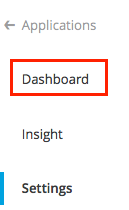
| The Dashboard option is available only if your organization has the Anypoint Integration Advanced package or a Titanium subscription to Anypoint Platform. |
The Insight button enables you to see data at a transaction level. See Insight.

| The dashboard and insights features are not currently available for Anypoint Platform Private Cloud Edition. See Deployment Options. |
Monitor Applications
The tools you use to monitor application events and server or virtual server performance depend on the deployment option. See Monitor Applications.
Update an Application
If you made changes to your application and want to deploy a new version:
-
Click Choose file on the deployment screen.
-
Select either Import file from Exchange or Upload file.
-
Click Apply changes.
Within a few seconds, your application redeploys. While redeploying, the application status indicator changes to blue, and then turns green after the deployment completes. -
For applications deployed to CloudHub, you can click Logs to see a live redeployment of your application.
If you’re deploying your application to an on-premises cluster, Runtime Manager installs the new app version simultaneously on each server.
To update applications deployed to Runtime Fabric, see Application Versioning on Runtime Fabric.
Grace Period
When you stop, restart, update, redeploy, or terminate an application, CloudHub tries to delete it from Mule. To make sure inflight messages are delivered, there’s a two-minute timeout period. After that period, CloudHub shuts down the whole instance. This grace period applies to the application instance, not to the runtime. The runtime uses its own configuration for shutdown. By default, the runtime grace period is five seconds.
Alerts
You can set up email alerts that are sent whenever certain events occur to your application, such as deployment failures or application deletions. These alerts can be linked to a specific application or to all applications. See Alerts for information.
Even if you don’t have permission to create alerts, you can specify whether to receive email alerts.
Switching an alert off from this view switches it off for the current (signed in) user only. Other users can still have active alerts.








